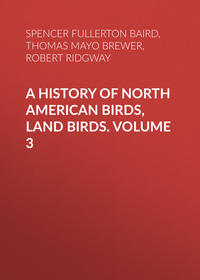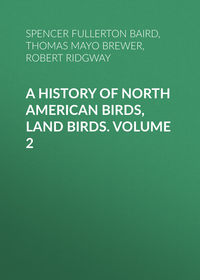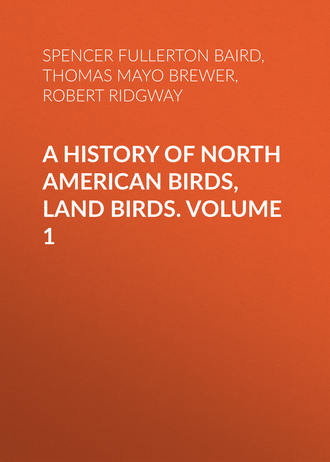 полная версия
полная версияA History of North American Birds, Land Birds. Volume 1
Nuttall and Townsend found it abundant among the western slopes of the Rocky Mountains, near the Columbia River, in October. In the winter it became still more numerous, passing the season in that region as well as in more southern localities, associating with the robin. From this bird it may be readily distinguished by the difference of its notes, which are louder, sharper, and delivered with greater rapidity. In the spring, before leaving for their breeding-places, they are described as having a very sweet warble.
On the Columbia River they were not resident, arriving there in October, continuing throughout the winter, and leaving early in May. During their stay they moved through the forest in small flocks, frequenting low trees, and for the most part keeping perfect silence. They were timorous and difficult of approach.
Its habits are said to resemble those of the robin, but in some of them the descriptions given appear to correspond more with those of the Fieldfares and Redwings of Europe. Like those species it is a summer resident of high northern latitudes, affects secluded forests and thickets bordering upon streams, and is found only in unfrequented localities.
Dr. Cooper was of the opinion that a few of these thrushes remained in Washington Territory throughout the summer, as he frequently met with them in the dark spruce forests of that region as late as June and July. He describes the song as consisting of five or six notes in a minor key, and in a scale regularly descending. It was heard continually throughout the summer, among the tops of the trees, but only in the densest forests. Dr. Suckley states that after a fall of snow they would be found along the sandy beaches near the salt water, where they were both abundant and tame. We are indebted to Mr. W. H. Dall for our first authentic knowledge of its nest and eggs. The former measures 6 inches in diameter with a depth of 2½ inches. It has but a very slight depression, apparently not more than half an inch in depth. The original shape of the nest had, however, been somewhat flattened in transportation. The materials of which it was composed were fine dry mosses and lichens impacted together, intermingled with fragments of dry stems of grasses.
A nest of this thrush obtained by Dr. Minor, in Alaska, is a much more finished structure. Its base and periphery are composed of an elaborate basket-work of slender twigs. Within these is an inner nest consisting of an interweaving of fine dry grasses and long gray lichens.
The eggs in size, shape, ground color, and markings are not distinguishable from those of the Turdus musicus of Europe. They measure 1.13 inches in length by .80 in breadth, are of a light blue with a greenish shading, almost exactly similar to the ground color of the T. migratorius. They are very distinctly marked and spotted with a dark umber-brown approaching almost to blackness.
Mr. Dall informs us that the nest found by him was built in a willow bush, about two feet from the ground, and on the top of a large mass of rubbish lodged there by some previous inundation. Other nests of the same species were met with in several places between Fort Yukon and Nulato, always on or near a river-bank and in low and secluded localities.
They arrive at Nulato about May 15, and prefer the vicinity of water, frequenting the banks of small streams in retired places. Mr. Dall states that he has seen the male bird on a prostrate log near the nest, singing with all his might, suddenly cease and run up and down the log for a few minutes, strutting in a singular manner, then stopping and singing again; and keeping up this curious performance. Specimens were received from Sitka, Kodiak, Cook’s Inlet and Admiralty Islands.
Subfamily MIMINÆ
Birds of this section have a somewhat thrush-like appearance, but (except in Oreoscoptes) with longer, much more graduated, and broader tail; short concave wings, about equal to or shorter than the tail, usually lengthened, sometimes decurved bill without notch, and strongly marked scutellæ on the anterior face of the tarsus. The loral feathers are soft, and not ending in bristly points. The colors are dull shades of brown, gray, or plumbeous. Most of the species, in addition to a melodious native song, possess the power of imitating the notes of other birds; sometimes, as in the American Mocking Bird, to an eminent degree. All are peculiar to the New World, and the species are much less vagrant than those of the Turdinæ,—those of the United States scarcely going beyond its northern boundary; others, again, restricted to small islands in the West Indies or in the Pacific Ocean.
Genus OREOSCOPTES, BairdOreoscoptes, Baird, Birds N. Am. 1858, 346. (Type Orpheus montanus, Towns.)
Oreoscoptes, Baird, Rev. Am. Birds, 42.
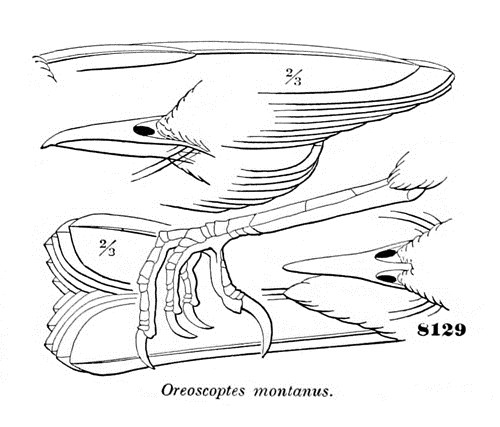
Oreoscoptes montanus.
8129
Sp. Char. Bill shorter than the head, without distinct notch. Bristles prominent, their tips reaching beyond the nostrils. Wings pointed, equal to, or a little longer than the tail. First quill not half the second, about two fifths the longest; third, fourth, and fifth quills equal and longest; second between sixth and seventh. Tail but slightly graduated; the feathers narrow. Tarsus longer than middle toe and claw by an additional claw; scutellæ distinct anteriorly.
Of this genus only one species is at present known. This belongs to the Middle and Western provinces of the United States and extends from the Pacific coast eastward to Fort Laramie and the Black Hills (in winter to San Antonio, Texas); south to Fort Yuma and Cape St. Lucas.
Oreoscoptes montanus, BairdSAGE THRASHER; MOUNTAIN MOCKEROrpheus montanus, Townsend, Jour. Acad. Nat. Sci. Phila. VII, II, 1837, 192.—Aud. Birds Amer. II, 1841, 194, pl. cxxxix. Turdus montanus, Aud. Orn. Biog. IV, 1838, 437, pl. ccclxix, fig. 1. Mimus montanus, Bonap. Consp. 1850, 276. Oreoscoptes montanus, Baird, Birds N. Amer. 1858, 347; Rev. Am. B. 1864, 42.—Sclater, P. Z. S. 1859, 340.—Ib. Catal. 1861, 8, No. 30.—Cooper, Birds Cal. 1, 12.
Sp. Char. First quill rather shorter than the sixth. Tail slightly graduated. Above brownish-ash; each feather obsoletely darker in the centre. Beneath dull white, thickly marked with triangular spots, except on the under tail-coverts and around the anus, which regions are tinged with yellowish-brown. Wing-coverts and quills edged with dull white. Tail feathers brown; the outer edged, and all (except, perhaps, the middle) tipped with white. Length, 8 inches; wing, 4.85; tail, 4.00; tarsus, 1.21.
Young. Similar, but spots beneath less sharply defined, and the upper parts quite conspicuously streaked with dusky.
Hab. Rocky Mountains of United States, west to Pacific, south to Cape St. Lucas.

Oreoscoptes montanus.
The careful observations of Mr. Robert Ridgway have led him to the conviction that the name bestowed upon this species of “Mountain Mocking-Bird” is doubly a misnomer. It is not at all imitative in its notes, and it is almost exclusively a resident of the artemisia plains. It seems to be chiefly confined to the great central plateau of North America, from Mexico almost to Washington Territory. Specimens have been procured from Cape St. Lucas, the Lower Colorado, Mexico, and Texas, on the south, and Nuttall met with it nearly as far north as Walla-Walla. It probably occupies the whole extent of the Great Basin.
Dr. Kennerly, who met with it while crossing the arid mesas west of the Rio Grande, says that while singing it was usually perched upon some bush or low tree. It was frequently seen seeking its food upon the ground, and when approached, instead of flying away, it ran very rapidly, and disappeared among the low bushes.
During the winter months it was observed near San Antonio, Texas, by Mr. Dresser; and was also found by him to be common about Eagle Pass. He noticed the same peculiarity of their running instead of their flying away when disturbed. They preferred the flat, bush-covered plains. A few remained to breed, as he obtained the eggs there, although he did not himself meet with one of the birds in summer.
It is generally represented as keeping chiefly on the ground, and obtaining its food in this position. General Couch speaks of it as Sparrow-like in its habits.
Mr. Nuttall describes its song as cheering, and the notes of which it is composed as decidedly resembling those of the Brown Thrush (Harporhynchus rufus). He claims for it some of the imitative powers of the Mocking-Bird (Mimus polyglottus), but in this he is not supported by the observations of others. He met with its nest in a wormwood (Artemisia) bush on the border of a ravine; it contained four eggs of emerald green, spotted with dark olive, the spots being large, roundish, and more numerous at the larger end. The nest was composed of small twigs and rough stalks, and lined with strips of bark and bison-wool. The female flew off to a short distance, and looked at her unwelcome visitors without uttering any complaint.
The nests of this bird, so far as I have seen them, are all flat, shallow structures, with very slight depression, and loosely and rudely constructed of an intermingling of strips of bark with rootlets and the finer stems of herbaceous plants. Their eggs, usually four in number, do not vary essentially in size, shape, or marking. They measure 1 inch in length, and from .73 to .75 in breadth. Their ground color is a bright greenish-blue, marked with deep olive-brown spots, intermingled with blotches of a light lilac. There are slight variations in the proportion of green in the shade of the ground color, and also in the number and size of the spots, but these variations are unimportant.
The following are Mr. Ridgway’s observations upon the habits of this species. They are full, valuable, and very carefully made:—
The Oreoscoptes montanus is a bird peculiar to the artemisia wastes of the Great Basin, being a characteristic species of the region between the Sierra Nevada and the Rocky Mountains. It is exclusively an inhabitant of the “sage brush,” and is partial to the lower portions of the country, though it is not unfrequent on the open slope of the mountains. A more unappropriate term than “Mountain Mocking-Bird” could hardly have been chosen for this species, as its predilection for the valleys, and the fact that its song is entirely its own, will show. In my opinion, the term “Sage Thrasher” would be more appropriate.
In the neighborhood of Carson City, Nevada, these birds arrived about the 24th of March, and immediately upon their arrival began singing. At this time, with the Sturnella neglecta and Poospiza belli, they made sweet music in the afternoon and early morning, in the open wastes of “sage brush,” around the city. The birds when singing were generally seen sitting upon the summit of a “sage” bush, faintly warbling, in the course of the song turning the head from side to side in a watchful manner. Upon being approached, they would dart downward, seemingly diving into the bush upon which they had perched, but upon a close search the bird could not be found, until it was heard again singing a hundred yards or more in the direction from which I had approached. This peculiar, circuitous, concealed flight is a very characteristic trait of this bird, and one sure to excite attention.
As the season advanced, or about the 10th of April, when the pairing season was at hand, the songs of the males became greatly improved, increasing in sweetness and vivacity, and full of rapturous emotion; their manners, also, became changed, for they had lost all their wariness. In paying their attentions to their mates, the males would fly from bush to bush, with a peculiar, tremulous fluttering of the wings, which, when the bird alighted, were raised above the back apparently touching each other; all the while vibrating with the emotion and ecstasy that agitated the singer.
The song of this bird, though very deficient in power,—in this respect equalling no other species of Miminæ with which I am acquainted,—is nevertheless superior to most of them in sweetness, vivacity, and variety. It has a wonderful resemblance to the beautiful subtle warbling of the Regulus calendula, having in fact very much the same style, with much of the tone, and about the power of the song of the Pyranga rubra.
When the birds are engaged in incubation, the males become very silent, and one not familiar with their habits earlier in the season would think they never had a voice; in fact, they make no protestations even when the nest is disturbed, for, while blowing the eggs, I have had the parent birds running around me, in the manner of a robin, now and then halting, stretching forward their heads, and eying me in the most anxious manner, but remaining perfectly silent. When the young are hatched the parents become more solicitous, signifying their concern by a low, subdued chuck. At all times when the nest is approached, the bird generally leaves it slyly before one approaches very near it.
The nest is very bulky, composed externally of rough sticks, principally the thorny twigs of the various “sage bush” plants. Nearer the centre the principal material is fine strips of inner bark of these plants; and the lining consists of finer strips of bark, mingled with fine roots, and bits of rabbit fur. The situation of the nest varies but little, being generally placed near the middle of a bush, that is, about eighteen inches from the ground. It is generally supported against the main trunk, upon a horizontal branch. Several were found upon the ground beneath the bush, one, in fact, embedded in the soil, like that of a Pipilo; or as sometimes the case with the Harporhynchus rufus, others, again, were found in brush-heaps. In all cases, the nest was very artfully concealed, the situation being so well selected.
This bird is almost equally common in all parts of its habitat, within the limits indicated. In June, we found it abundant on the large islands in the Great Salt Lake, where many nests were found.
In autumn, it feeds, in company with many other birds, upon berries, “service berries” being its especial favorite.
Genus HARPORHYNCHUS, CabanisToxostoma, Wagler, Isis, 1831, 528. (Type T. vetula, Wagl., not Toxostoma, Raf. 1816.)
Harpes, Gambel, Pr. A. N. S. Phila. II. 1845, 264. (Type Harpes redivivus, Gamb., not of Goldfuss, 1839.)
Harporhynchus, Cabanis, Archiv f. Naturg. 1848, I. 98. (Type Harpes redivivus, Gamb.)
Methriopterus, Reich. Av. Syst. Nat. 1850, pl. iv. (Type said by Gray to be H. rufus.)
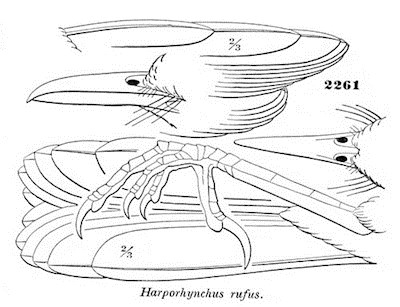
Harporhynchus rufus.
2261
Gen. Char. Bill from forehead as long as, or much longer than the head; becoming more and more decurved in both jaws as lengthened. No indication of a notch. Rictus with the bristles extending beyond the nostrils. Tarsus long and stout, appreciably exceeding the middle toe and claw, strongly scutellate anteriorly. Wings considerably shorter than tail, much rounded; the first quill more than half the second; fourth or fifth longest. Tail large, much graduated; the feathers firm.
The species of this genus are all of large size, in fact, embracing the largest of the American slender-billed oscine birds. All the species differ in structure, varying especially in the length of the bill, as above stated.
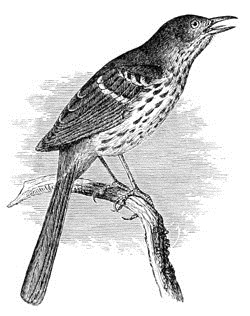
Harporhynchus rufus.
It is useless to attempt a division of this genus, for there is such a gradual chain of characters between the two extremes of form (rufus and crissalis), that they even seem almost one species, when the numerous intermediate forms, shading so insensibly into each other, are considered. However, as this view would be rather extreme, in view of the really great difference of form between the species mentioned, we may consider the following as good species, several of them with one or more varieties: rufus, with longicauda and longirostris as varieties, the former scarcely appreciably different, the latter ranking as a permanent race; ocellatus, cinereus, curvirostris, the latter with one well-marked variety, palmeri; redivivus, with most probably lecontei as a well-marked variety, and crissalis.
The seasonal differences in the plumage often make it difficult to determine these several forms; but if the following facts are borne in mind, the trouble will be greatly lessened. In every species there is a more or less decided ochraceous tinge to the crissal region (sometimes extending forward over the flanks); except in crissalis, in which the lower tail-coverts and anal region are deep chestnut. In autumn and winter this ochraceous tint becomes very much deeper, as well as more prevalent, than in spring and summer; the whole plumage becomes softer, the colors more pronounced, and the markings more distinct, than when faded and worn in summer.
Synopsis of Species of HarporhynchusA. Spots beneath sharply defined and conspicuous,—much darker in color than the upper parts.
1. H. rufus. The markings lineo-cuneate; wing bands sharply defined.
Above rufous; markings below dark brown; outer tail-feathers diluted at tip; wing, 4.00; tail, 5.20; bill from nostril, .79, nearly straight; tarsus, 1.30; middle toe, .90 (1,377 ♂ Carlisle, Penn.). Hab. Eastern Province United States … var. rufus.
Wing, 4.40; tail, 5.70; bill, .79; tarsus, 1.35; middle toe, .90 (5,652 ♂ Republican River). Hab. Plains between Missouri River to Rocky Mountains … var. longicauda.
Above umber brown; markings beneath black; tail-feathers not paler at tip; wing, 3.90; tail, 4.90; bill, .85, slightly curved; tarsus, 1.40; middle toe, .94 (4,016 ♂ Brownsville, Tex.) Hab. Eastern Mexico, north to Rio Grande of Texas … var. longirostris.
2. H. ocellatus.23 The markings circular; wing bands conspicuous.
Above grayish-brown; markings beneath black; tail-feathers broadly tipped with white; wing, 4.10; tail, 5.60; bill, from rictus, 1.50, moderately curved; tarsus, 1.50. Hab. Oaxaca, Mex.
3. H. cinereus. The markings deltoid; wing bands narrow, but sharply defined.
Above brownish-cinereous; markings beneath blackish-brown; tail-feathers broadly tipped with white; wing, 4.00; tail, 4.60; bill, .88, much curved; tarsus, 1.30; middle toe, .85 (12,960 “♀”—♂? Cape St. Lucas). Hab. Cape St. Lucas, Lower California.
B. Spots beneath obsolete, not darker than the plumage above; roundish in form.
4. H. curvirostris.
Above cinereous; wing bands distinct; spots below distinct, upon a white ground; femoral region and crissum very pale ochraceous; tail-feathers broadly and sharply tipped with pure white; wing, 4.30; tail, 4.50; bill, 1.00, stout, moderately curved; tarsus, 1.40; middle toe, 1.12 (7,200 ♂ Ringgold Barracks, Texas). Hab. from Rio Grande valley in Texas to Cordova, Orizaba, Oaxaca, Colima, and Mazatlan … var. curvirostris.
Wing bands obsolete, and tail spots very narrow and obsolete; spots below just discernible upon a grayish ground; femoral region and crissum dilute ochraceous-brown; wing, 4.30; tail, 5.20; bill, 1.00, slender, moderately curved; tarsus, 1.30; middle toe, 1.00 (8,128 ♂ “New Mexico”—probably Eastern Arizona). Hab. Arizona (Camp Grant) … var. palmeri.
C. Entirely unspotted beneath.
5. H. redivivus. Anal region and lower tail-coverts light ochraceous.
Above soft brownish-cinereous, tail considerably darker; wing bands almost obsolete, and tail-feathers merely diluted at tips. Beneath paler than above,—almost white on throat and abdomen; anal region and lower tail-coverts yellowish-ochraceous. A distinct “bridle” formed by the hair-like tips of the feathers, bordering the throat; maxillary stripe white with transverse bars of dusky; wing, 3.90; tail, 5.25; bill, 1.05, slender, moderately curved; tarsus, 1.25; middle toe, .86 (40,718 ♂ 20 miles from Colorado River, near Fort Mojave). Hab. Arizona (Gila River, Fort Yuma, and Fort Mojave) … var. lecontei.
Above ashy drab, tail darker and more brownish; wing bands inconspicuous, and tail-feathers hardly diluted at tips. Beneath, the ochraceous covers the abdomen, and the throat inclines to the same. No “bridle.” Cheeks and ear-coverts blackish, with conspicuous shaft-streaks of white; wing, 4.30; tail, 5.60; bill, 1.40, stout, very much bowed,—the arch regular; tarsus, 1.55; middle toe, 1.00 (3,932 ♂, California). Hab. Coast region of California … var. redivivus.
6. H. crissalis. Anal region and lower tail-coverts deep chestnut.
Above, brownish-ashy with a slight purplish cast, tail not darker; no trace of wing bands; tail-feathers diluted, and tinged with rusty at tips. Beneath, of a uniform, paler tint than the upper plumage, not lighter medially; throat white, with a conspicuous “bridle”; from this up to the eye whitish, with transversely angular bars of dusky; wing, 4.00; tail, 6.50; bill, 1.25, very slender, bowed from the middle; tarsus, 1.30; middle toe, .90 (11,533 ♂ Fort Yuma). Hab. Region of Gila River to Rocky Mountains; north to Southern Utah (St. George, breeding; Dr. Palmer).
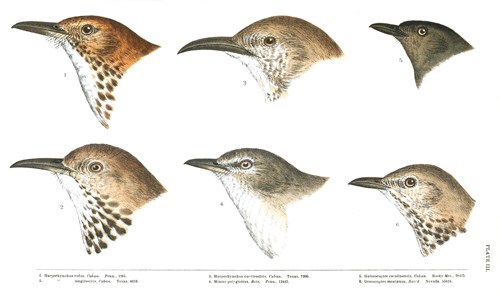
PLATE III.
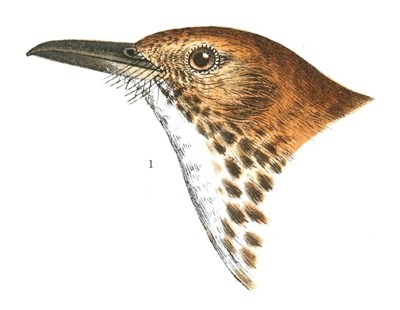
1. Harporhynchus rufus, Caban. Penn., 2261.
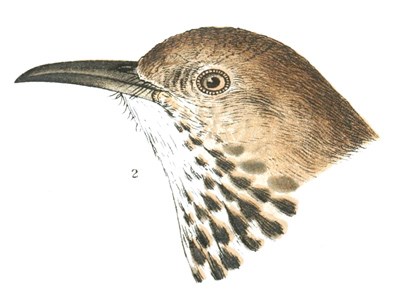
2. Harporhynchus longirostris, Caban. Texas, 4016.
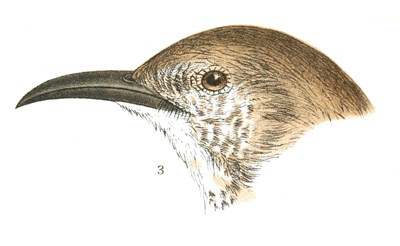
3. Harporhynchus curvirostris, Caban. Texas, 7200.

4. Mimus polyglottus, Boie. Penn., 12445.
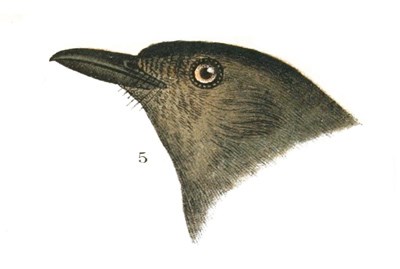
5. Galeoscoptes carolinensis, Caban. Rocky Mts., 38425.
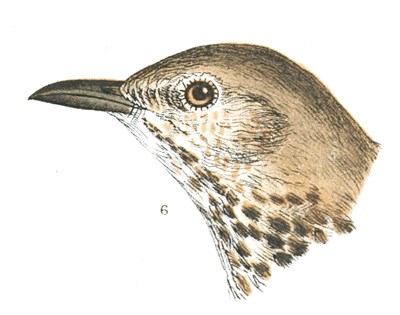
6. Oreoscoptes montanus, Baird. Nevada, 53424.
Harporhynchus rufus, CabanisBROWN THRASHER
Turdus rufus, Linn. Syst. Nat. 10th ed. 1758, 169, based on Catesby, tab. 19.—Ib. Syst. Nat. I, 1766, 293.—Gätke, Naumannia, 1858, 424 (Heligoland, Oct. 1837). Harporhynchus rufus, Cab. Mus. Hein. 1850, 82.—Baird, Birds N. Am. 1858, 353.—Ib. Rev. Am. Birds, 44.—Sclater, P. Z. S. 1859, 340.—Ib. Catal. 1861, 8, no. 48.—Samuels, 163. Mimus rufus, Pr. Max. Cab. Jour. 1858, 180.
Figures: Vieillot, Ois. Am. Sept. II, pl. lix.—Wilson, Am. Orn. II, pl. xiv.—Aud. Orn. Biog. pl. cxvi.
Sp. Char. Exposed portion of the bill shorter than the head. Outline of lower mandible straight. Above light cinnamon-red; beneath pale rufous-white with longitudinal streaks of dark brown, excepting on the chin, throat, middle of the belly, and under tail-coverts. These spots anteriorly are reddish-brown in their terminal portion. The inner surface of the wing and the inner edges of the primaries are cinnamon; the concealed portion of the quills otherwise is dark brown. The median and greater wing-coverts become blackish-brown towards the end, followed by white, producing two conspicuous bands. The tail-feathers are all rufous, the external ones obscurely tipped with whitish; the shafts of the same color with the vanes. Length, 11.15; wing, 4.15; tail, 5.20; tarsus, 1.30.




